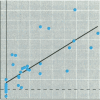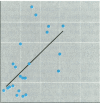Abstract
Consumption of fish and shellfish from contaminated areas may be an important source of human exposure to persistent organohalogen compounds such as polychlorinated biphenyls (PCBs), polychlorinated dibenzo-p-dioxins (PCDDs), and polychlorinated dibenzofurans (PCDFs). We determined concentrations of 2,3,7,8-substituted PCDDs and PCDFs and 19 PCB congeners in whole blood samples from three groups of men, 40-54 years of age, with different consumption levels of crabs from a fjord area in southern Norway polluted with organochlorine compounds from a magnesium production plant. A significant increase of many PCDD/PCDF congeners was found in the blood when comparing the referents, moderate-, and high-intake groups. The greatest difference was observed for several of the PCDFs that are characteristic for the contamination of the marine biota of the fjord. PCBs, in general, play a minor role in the contamination of the fjord by the magnesium production process, except for the highly chlorinated congeners such as PCB-209. Nevertheless, almost all PCBs increased from the referents to the high-intake group. However, the relative concentrations of several highly chlorinated PCBs (particularly PCB-209) in blood are unexpectedly low compared to their abundance in crabs, indicating low uptake of these congeners. The exposure to PCDDs/PCDFs from crab consumption calculated from individual body burdens of these compounds were in good agreement with the intake estimated from previously measured concentrations in crabs, reported fishing sites, and consumption. Almost all subjects in the high-intake group exceeded the tolerable weekly intake of 35 pg TEQ/kg body weight/week proposed by a Nordic Expert Group.
Full text
PDF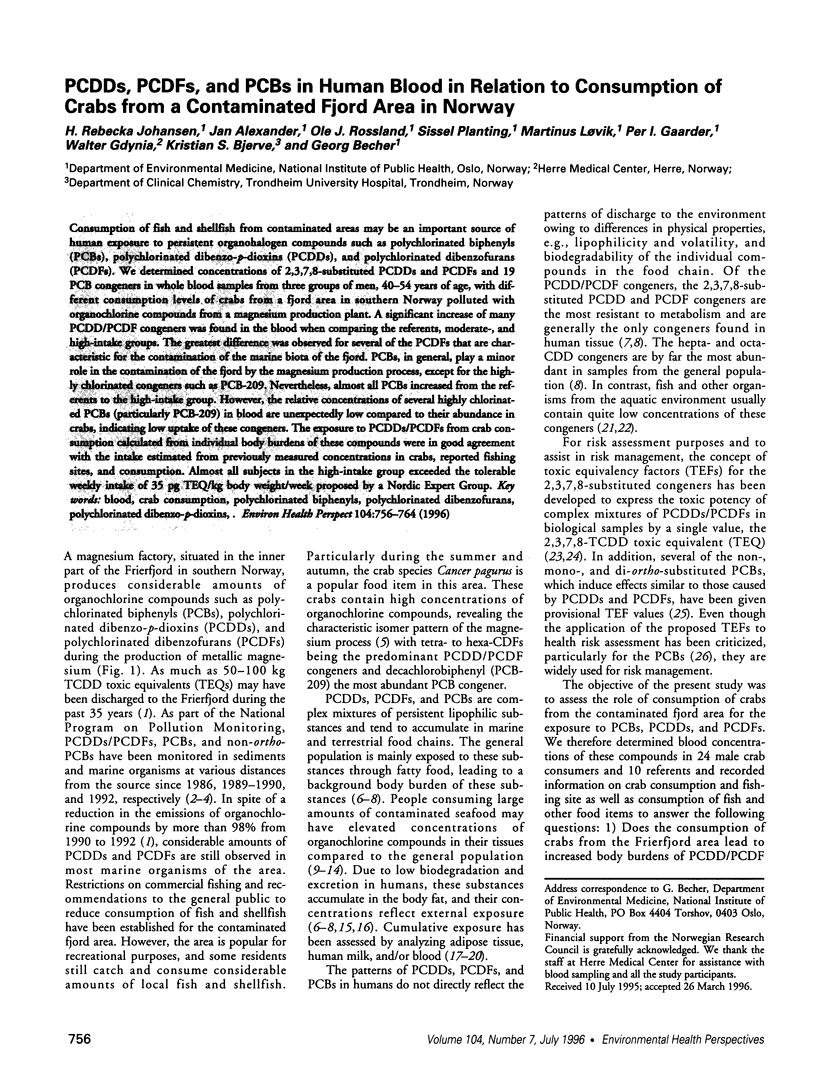

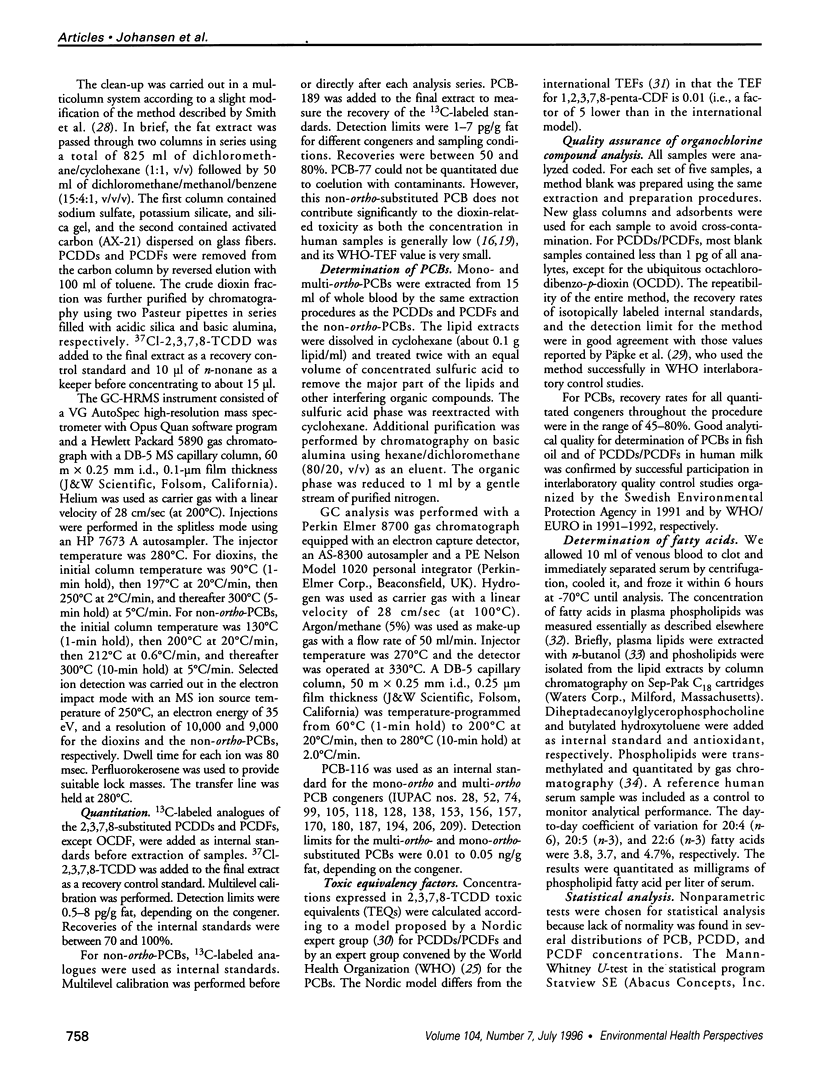

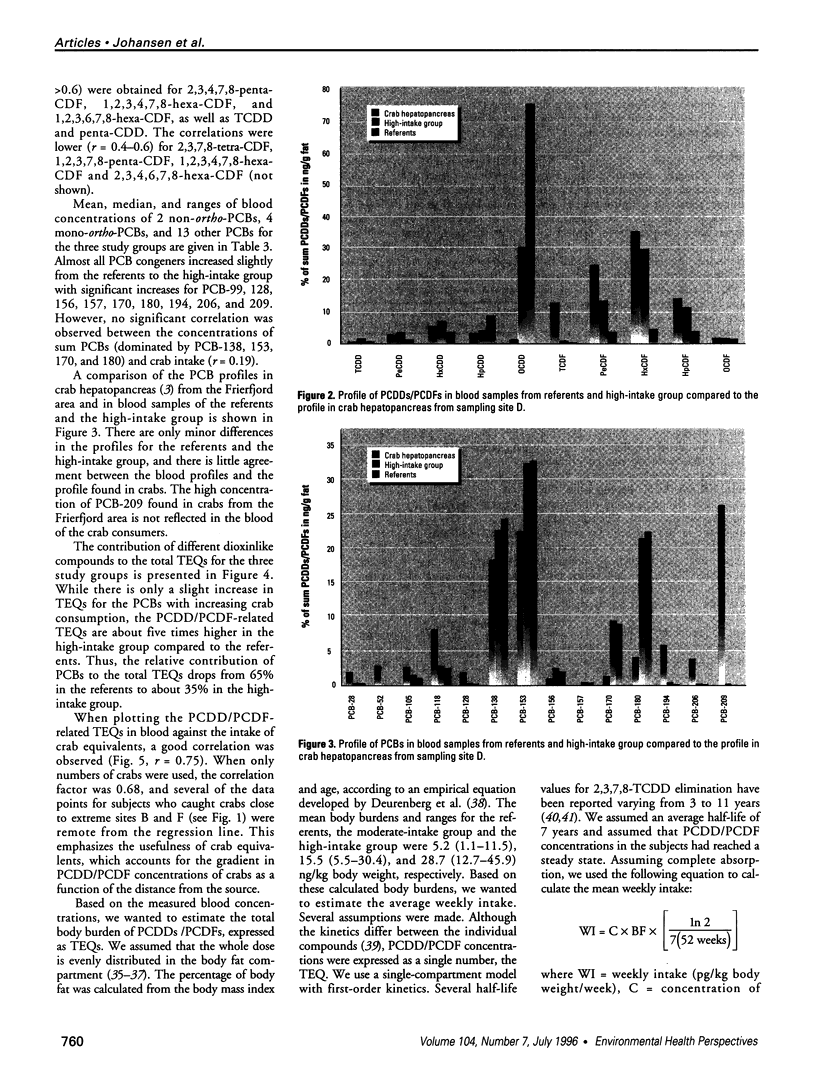

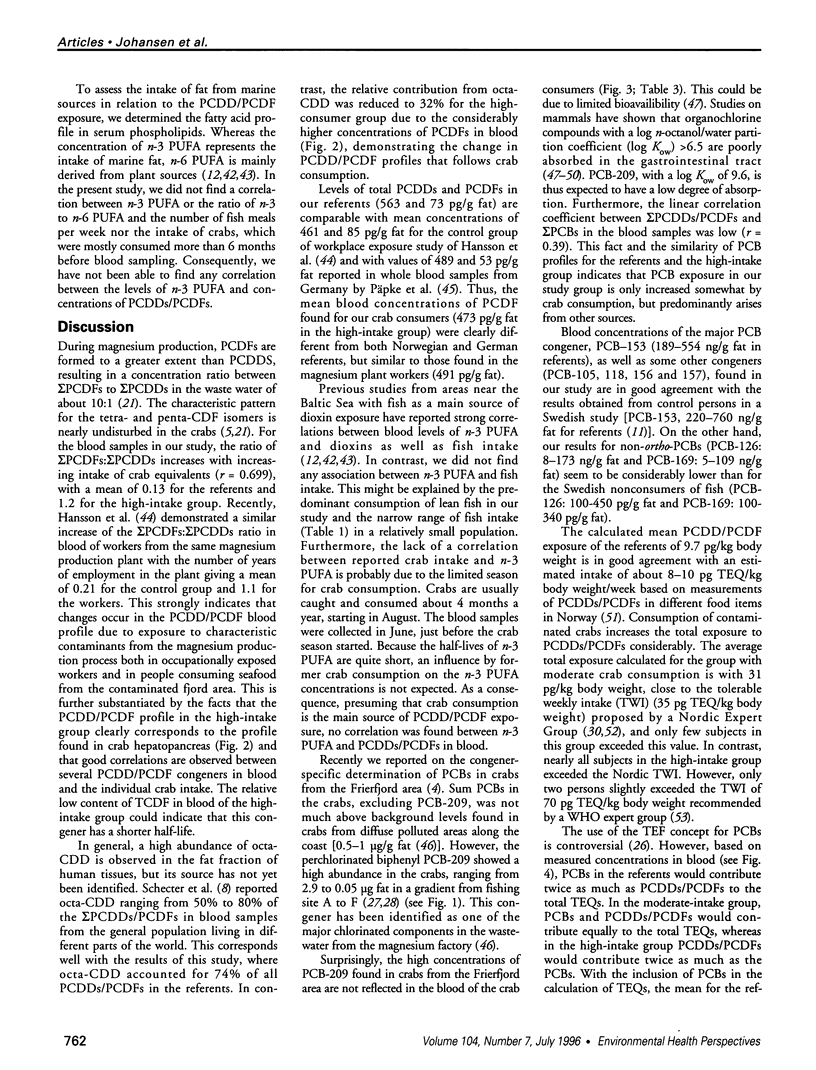
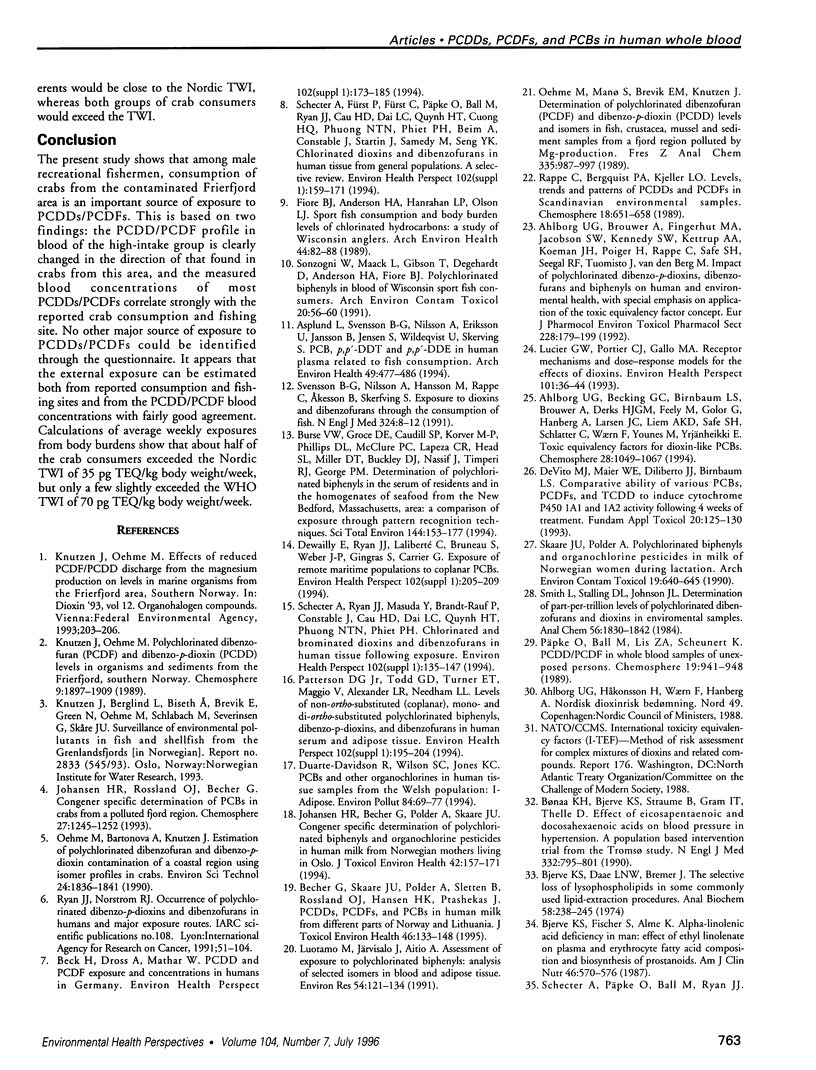

Images in this article
Selected References
These references are in PubMed. This may not be the complete list of references from this article.
- Ahlborg U. G., Brouwer A., Fingerhut M. A., Jacobson J. L., Jacobson S. W., Kennedy S. W., Kettrup A. A., Koeman J. H., Poiger H., Rappe C. Impact of polychlorinated dibenzo-p-dioxins, dibenzofurans, and biphenyls on human and environmental health, with special emphasis on application of the toxic equivalency factor concept. Eur J Pharmacol. 1992 Dec 1;228(4):179–199. doi: 10.1016/0926-6917(92)90029-c. [DOI] [PubMed] [Google Scholar]
- Asplund L., Svensson B. G., Nilsson A., Eriksson U., Jansson B., Jensen S., Wideqvist U., Skerfving S. Polychlorinated biphenyls, 1,1,1-trichloro-2,2-bis(p-chlorophenyl)ethane (p,p'-DDT) and 1,1-dichloro-2,2-bis(p-chlorophenyl)-ethylene (p,p'-DDE) in human plasma related to fish consumption. Arch Environ Health. 1994 Nov-Dec;49(6):477–486. doi: 10.1080/00039896.1994.9955004. [DOI] [PubMed] [Google Scholar]
- Becher G., Skaare J. U., Polder A., Sletten B., Rossland O. J., Hansen H. K., Ptashekas J. PCDDs, PCDFs, and PCBs in human milk from different parts of Norway and Lithuania. J Toxicol Environ Health. 1995 Oct;46(2):133–148. doi: 10.1080/15287399509532024. [DOI] [PubMed] [Google Scholar]
- Beck H., Dross A., Mathar W. PCDD and PCDF exposure and levels in humans in Germany. Environ Health Perspect. 1994 Jan;102 (Suppl 1):173–185. doi: 10.1289/ehp.94102s1173. [DOI] [PMC free article] [PubMed] [Google Scholar]
- Bjerve K. S., Daae L. N., Bremer J. The selective loss of lysophospholipids in some commonly used lipid-extraction procedures. Anal Biochem. 1974 Mar;58(1):238–245. doi: 10.1016/0003-2697(74)90463-1. [DOI] [PubMed] [Google Scholar]
- Bjerve K. S., Fischer S., Alme K. Alpha-linolenic acid deficiency in man: effect of ethyl linolenate on plasma and erythrocyte fatty acid composition and biosynthesis of prostanoids. Am J Clin Nutr. 1987 Oct;46(4):570–576. doi: 10.1093/ajcn/46.4.570. [DOI] [PubMed] [Google Scholar]
- Burse V. W., Groce D. F., Caudill S. P., Korver M. P., Phillips D. L., McClure P. C., Lapeza C. R., Jr, Head S. L., Miller D. T., Buckley D. J. Determination of polychlorinated biphenyl levels in the serum of residents and in the homogenates of seafood from the New Bedford, Massachusetts, area: a comparison of exposure sources through pattern recognition techniques. Sci Total Environ. 1994 Apr 29;144(1-3):153–177. doi: 10.1016/0048-9697(94)90436-7. [DOI] [PubMed] [Google Scholar]
- Bønaa K. H., Bjerve K. S., Straume B., Gram I. T., Thelle D. Effect of eicosapentaenoic and docosahexaenoic acids on blood pressure in hypertension. A population-based intervention trial from the Tromsø study. N Engl J Med. 1990 Mar 22;322(12):795–801. doi: 10.1056/NEJM199003223221202. [DOI] [PubMed] [Google Scholar]
- De Vito M. J., Maier W. E., Diliberto J. J., Birnbaum L. S. Comparative ability of various PCBs, PCDFs, and TCDD to induce cytochrome P450 1A1 and 1A2 activity following 4 weeks of treatment. Fundam Appl Toxicol. 1993 Jan;20(1):125–130. [PubMed] [Google Scholar]
- Deurenberg P., Weststrate J. A., Seidell J. C. Body mass index as a measure of body fatness: age- and sex-specific prediction formulas. Br J Nutr. 1991 Mar;65(2):105–114. doi: 10.1079/bjn19910073. [DOI] [PubMed] [Google Scholar]
- Dewailly E., Ryan J. J., Laliberté C., Bruneau S., Weber J. P., Gingras S., Carrier G. Exposure of remote maritime populations to coplanar PCBs. Environ Health Perspect. 1994 Jan;102 (Suppl 1):205–209. doi: 10.1289/ehp.94102s1205. [DOI] [PMC free article] [PubMed] [Google Scholar]
- Duarte-Davidson R., Wilson S. C., Jones K. C. PCBs and other organochlorines in human tissue samples from the Welsh population: I--Adipose. Environ Pollut. 1994;84(1):69–77. doi: 10.1016/0269-7491(94)90072-8. [DOI] [PubMed] [Google Scholar]
- Dyerberg J., Bang H. O., Hjorne N. Fatty acid composition of the plasma lipids in Greenland Eskimos. Am J Clin Nutr. 1975 Sep;28(9):958–966. doi: 10.1093/ajcn/28.9.958. [DOI] [PubMed] [Google Scholar]
- Fiore B. J., Anderson H. A., Hanrahan L. P., Olson L. J., Sonzogni W. C. Sport fish consumption and body burden levels of chlorinated hydrocarbons: a study of Wisconsin anglers. Arch Environ Health. 1989 Mar-Apr;44(2):82–88. doi: 10.1080/00039896.1989.9934380. [DOI] [PubMed] [Google Scholar]
- Hansson M., Grimstad T., Rappe C. Occupational exposure to polychlorinated dibenzo-p-dioxins and dibenzofurans in a magnesium production plant. Occup Environ Med. 1995 Dec;52(12):823–826. doi: 10.1136/oem.52.12.823. [DOI] [PMC free article] [PubMed] [Google Scholar]
- Johansen H. R., Becher G., Polder A., Skaare J. U. Congener-specific determination of polychlorinated biphenyls and organochlorine pesticides in human milk from Norwegian mothers living in Oslo. J Toxicol Environ Health. 1994 Jun;42(2):157–171. doi: 10.1080/15287399409531870. [DOI] [PubMed] [Google Scholar]
- Lucier G. W., Portier C. J., Gallo M. A. Receptor mechanisms and dose-response models for the effects of dioxins. Environ Health Perspect. 1993 Apr 22;101(1):36–44. doi: 10.1289/ehp.9310136. [DOI] [PMC free article] [PubMed] [Google Scholar]
- Luotamo M., Järvisalo J., Aitio A. Assessment of exposure to polychlorinated biphenyls: analysis of selected isomers in blood and adipose tissue. Environ Res. 1991 Apr;54(2):121–134. doi: 10.1016/s0013-9351(05)80095-7. [DOI] [PubMed] [Google Scholar]
- Patterson D. G., Jr, Needham L. L., Pirkle J. L., Roberts D. W., Bagby J., Garrett W. A., Andrews J. S., Jr, Falk H., Bernert J. T., Sampson E. J. Correlation between serum and adipose tissue levels of 2,3,7,8-tetrachlorodibenzo-p-dioxin in 50 persons from Missouri. Arch Environ Contam Toxicol. 1988 Mar;17(2):139–143. doi: 10.1007/BF01056017. [DOI] [PubMed] [Google Scholar]
- Patterson D. G., Jr, Todd G. D., Turner W. E., Maggio V., Alexander L. R., Needham L. L. Levels of non-ortho-substituted (coplanar), mono- and di-ortho-substituted polychlorinated biphenyls, dibenzo-p-dioxins, and dibenzofurans in human serum and adipose tissue. Environ Health Perspect. 1994 Jan;102 (Suppl 1):195–204. doi: 10.1289/ehp.94102s1195. [DOI] [PMC free article] [PubMed] [Google Scholar]
- Päpke O., Ball M., Lis A. PCDD/PCDF in humans, a 1993-update of background data. Chemosphere. 1994 Nov-Dec;29(9-11):2355–2360. doi: 10.1016/0045-6535(94)90404-9. [DOI] [PubMed] [Google Scholar]
- Ryan J. J., Norstrom R. J. Occurrence of polychlorinated dibenzodibenzo-p-dioxins and dibenzofurans in humans and major exposure routes. IARC Sci Publ. 1991;(108):51–104. [PubMed] [Google Scholar]
- Schecter A., Fürst P., Fürst C., Päpke O., Ball M., Ryan J. J., Hoang D. C., Le C. D., Hoang T. Q., Cuong H. Q. Chlorinated dioxins and dibenzofurans in human tissue from general populations: a selective review. Environ Health Perspect. 1994 Jan;102 (Suppl 1):159–171. doi: 10.1289/ehp.94102s1159. [DOI] [PMC free article] [PubMed] [Google Scholar]
- Schecter A., Ryan J. J., Masuda Y., Brandt-Rauf P., Constable J., Hoang D. C., Le C. D., Hoang T. Q., Nguyen T. N., Pham H. P. Chlorinated and brominated dioxins and dibenzofurans in human tissue following exposure. Environ Health Perspect. 1994 Jan;102 (Suppl 1):135–147. doi: 10.1289/ehp.94102s1135. [DOI] [PMC free article] [PubMed] [Google Scholar]
- Skaare J. U., Polder A. Polychlorinated biphenyls and organochlorine pesticides in milk of Norwegian women during lactation. Arch Environ Contam Toxicol. 1990 Sep-Oct;19(5):640–645. doi: 10.1007/BF01183978. [DOI] [PubMed] [Google Scholar]
- Smith L. M., Stalling D. L., Johnson J. L. Determination of part-per-trillion levels of polychlorinated dibenzofurans and dioxins in environmental samples. Anal Chem. 1984 Sep;56(11):1830–1842. doi: 10.1021/ac00275a018. [DOI] [PubMed] [Google Scholar]
- Sonzogni W., Maack L., Gibson T., Degenhardt D., Anderson H., Fiore B. Polychlorinated biphenyl congeners in blood of Wisconsin sport fish consumers. Arch Environ Contam Toxicol. 1991 Jan;20(1):56–60. doi: 10.1007/BF01065328. [DOI] [PubMed] [Google Scholar]
- Svensson B. G., Akesson B., Nilsson A., Skerfving S. Fatty acid composition of serum phosphatidylcholine in healthy subjects consuming varying amounts of fish. Eur J Clin Nutr. 1993 Feb;47(2):132–140. [PubMed] [Google Scholar]
- Svensson B. G., Nilsson A., Hansson M., Rappe C., Akesson B., Skerfving S. Exposure to dioxins and dibenzofurans through the consumption of fish. N Engl J Med. 1991 Jan 3;324(1):8–12. doi: 10.1056/NEJM199101033240102. [DOI] [PubMed] [Google Scholar]
- Wolfe W. H., Michalek J. E., Miner J. C., Pirkle J. L., Caudill S. P., Patterson D. G., Jr, Needham L. L. Determinants of TCDD half-life in veterans of operation ranch hand. J Toxicol Environ Health. 1994 Apr;41(4):481–488. doi: 10.1080/15287399409531858. [DOI] [PubMed] [Google Scholar]






